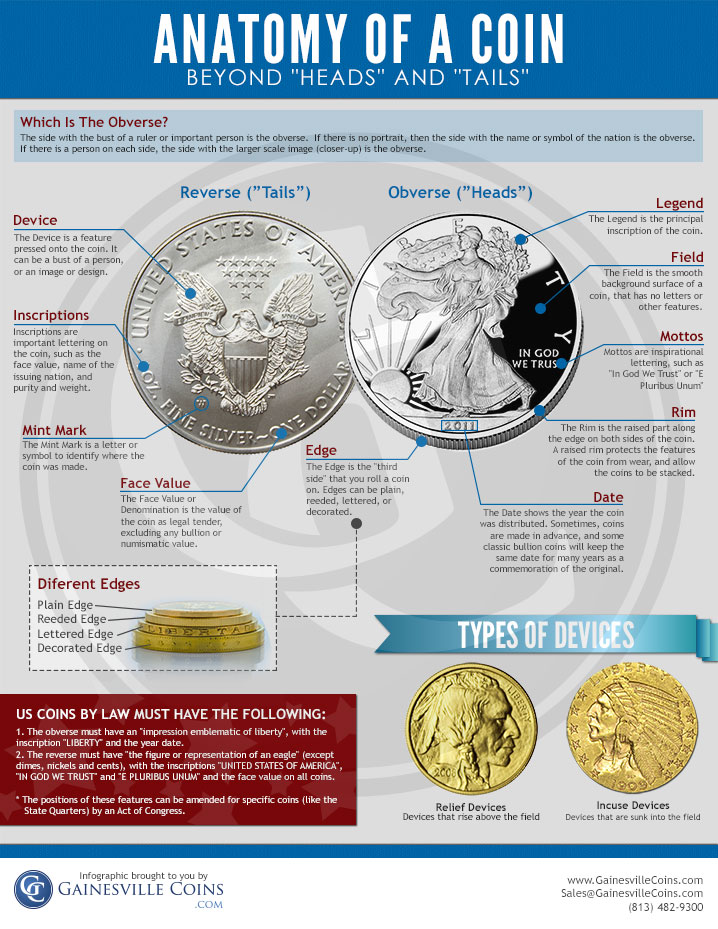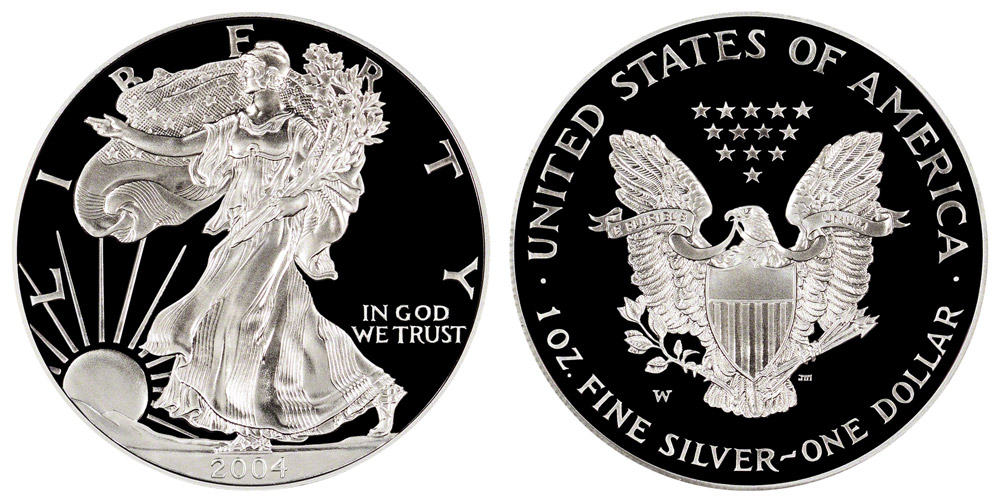Anatomy of a Coin: How to Identify Coins On Sight
You have probably heard of the "heads" and "tails" sides of a coin. But there is so much more to take note of on any legal tender coin!
Let's break down each element of a coin's design with the handy infographic below.

If you would like to print out the infographic above for educational uses, please follow the link to the Anatomy of a Coin infographic.
Which Side of the Coin Is the Obverse ("Heads")?
The heads side of the coin is technically called the obverse. This simply means it is the front of the coin.
Fittingly, the obverse is typically where you will find an actual head or face. This is usually the portrait of a national leader or a symbolic representation of the country.
Sometimes, the obverse will not feature a person at all. In these cases, you can normally tell which side is supposed to be the front by the presence of the date.
Keep in mind that there is no concrete rule about which side must be considered the obverse. It is a matter of convention.
Which Side of the Coin Is the Reverse ("Tails")?
The tails side or back side of the coin is referred to as the reverse. It usually features the name of the country that issued that coin.
Again, there is no uniform rule for which side of the coin is heads or tails. You might even find a person's face on the reverse of a coin on some occasions.
Other Devices On the Coin
Any image or writing on a coin can be called a device. It's simply another way of describing a feature of a coin's design.
Certain devices are required by law to appear on all United States legal tender coins:
- The obverse must feature "an impression emblematic of liberty," the date (year of issue), and the inscription "LIBERTY."
- The reverse must feature "the figure or representation of an eagle" (except for pennies, nickels, and dimes), and inscriptions for "IN GOD WE TRUST," "E PLURIBUS UNUM," and "UNITED STATES OF AMERICA."
Definitions of Various Devices on Coins
- Field: the smooth background surface of a coin. The field is the blank space between other features on the coin.
- Rim: the raised area along the perimeter of the coin. Rims help protect the coin design from excessive wear and make coins easier to stack.
- Edge: the area along the thickness of the coin, sometimes referred to as the "third side" of the coin. Often confused with the rim.
- Inscriptions: any words or lettering on the coin.
- Legend: the main inscription on a coin.
- Mottos: any national- or cultural-specific inscriptions on a coin, such as "IN GOD WE TRUST."
- Mint Mark: any letters or symbols that indicate the location where the coin was made. It is sometimes expressed as one word, mintmark.
- Face Value: the value of a coin as legal-tender money, e.g. the face value of a nickel is five cents. This is also known as a coin's denomination.
- Year-Date: the date the coin was issued by a government entity.
Coins Can Have Different Edge Designs
The edge of the coin may have its own design.
The simplest edge design is a plain edge. It is smooth and featureless.
Probably the most common edge design is a reeded edge. This is also called a serrated edge or milled edge. Reeded edges look like a series of vertical lines along the edge of the coin. The reeding was also used to make it obvious if small amounts of metal had been filed away from the coin.

A view of the edge of a stack of quarters.
A lettered edge features inscriptions along the edge of the design.
Similarly, a decorative edge will show other symbols or decorations, such as stars.
Coin Surfaces and Different Finishes on Coins
There are two different ways that an image can be imparted onto a coin's surface: relief or incuse.
The much more common method is called relief. In sculpture, you may see this technique called bas-relief. With relief, an image is created by the features of the coin being raised above the field. You can check this yourself by closely examining a coin from its edge.
On the other hand, incuse designs are basically the opposite process. The design is created by engraving down into the surface of the coin, so the design features are all below the field. In the art world, incuse is often called intaglio.

The Indian Head design by artist Bela Lyon Pratt is among the only incuse coin designs you will ever find. It appeared on $5 and $2.50 gold coins in the U.S. from 1908 to 1929.
Coins With Special Finishes
Some coins—especially those made for collectors—will exhibit special finishes. These finishes help to highlight or enhance the beauty of the coin's design.
The standard finish for today's coins is Brilliant Uncirculated, abbreviated as "BU". This is the normal, shiny finish that many of us have come to expect on coins. Brilliant Uncirculated finishes impart an attractive cartwheel luster to the coin.
A proof finish is very popular for collectible coins. Proof coins feature specially polished fields that have a mirror-like appearance. The relief devices stand out against this mirrored background due to being "frosted."

2004-W Proof American Silver Eagle. When photographed, proof coins typically appear to have a black background.
In addition to proof and BU, mints around the world have developed other eye-appealing finishes for certain special edition coins. These include colorized coins, reverse proof coins, and other forms of enhanced uncirculated finishes (sometimes called burnished, sandblasted, or satin proofs).
Understanding the "Anatomy" of Your Coin
There is a clear reason why this information is important to know. You will find it far easier to identify a coin when you understand its anatomy! Identifying your coins is the first step toward determining the coins' value, as well.
More resources to learn about coins and precious metals from Gainesville Coins:
Check Your Change: You Might Strike Silver
Coin Library: Catalogue of United States Coins
The Ultimate Gold Investing Guide
The 15 Most Valuable Jefferson Nickels: A Visual Guide

Everett Millman
Everett has been the head content writer and market analyst at Gainesville Coins since 2013. He has a background in History and is deeply interested in how gold and silver have historically fit into the financial system.
In addition to blogging, Everett's work has been featured in Reuters, CNN Business, Bloomberg Radio, TD Ameritrade Network, CoinWeek, and has been referenced by the Washington Post.
